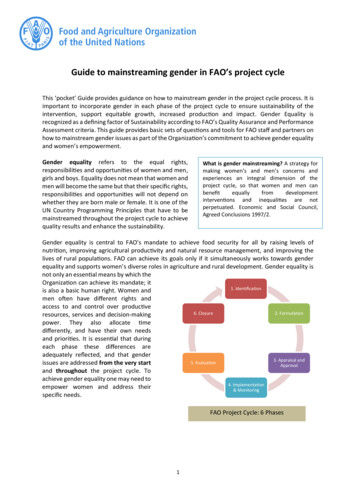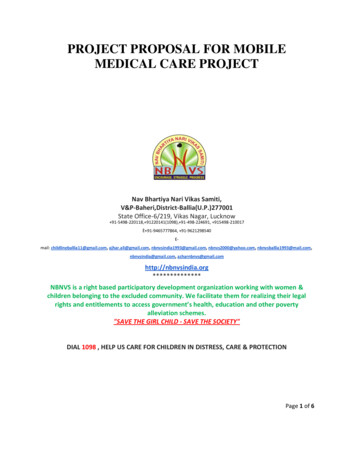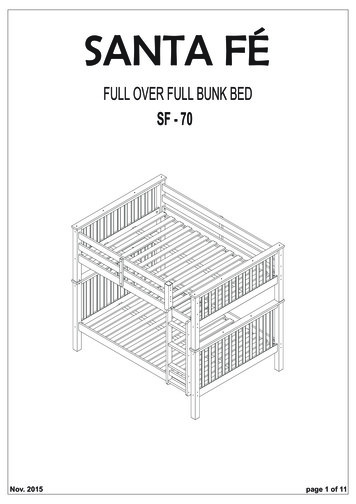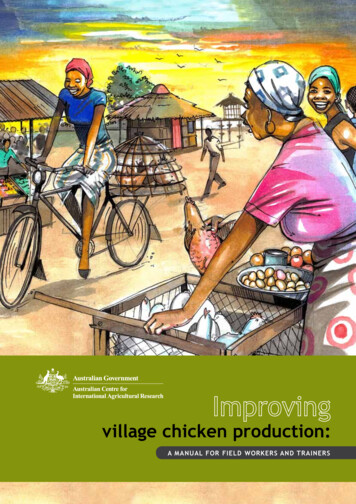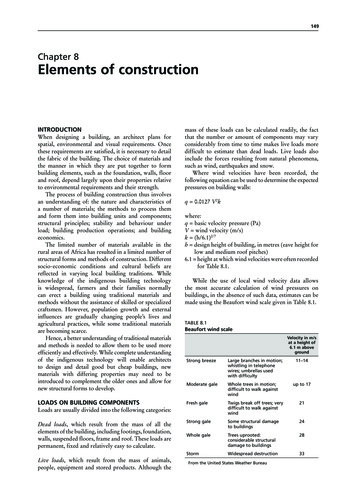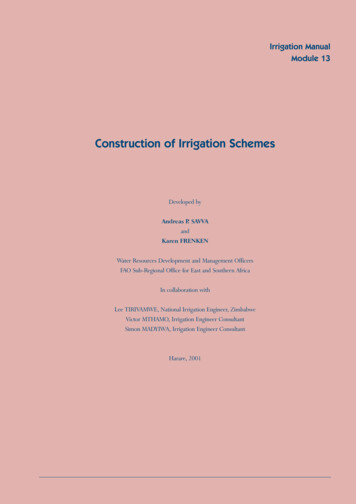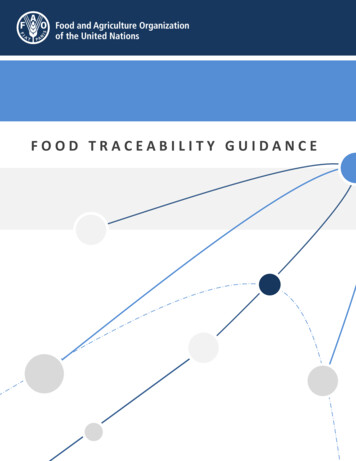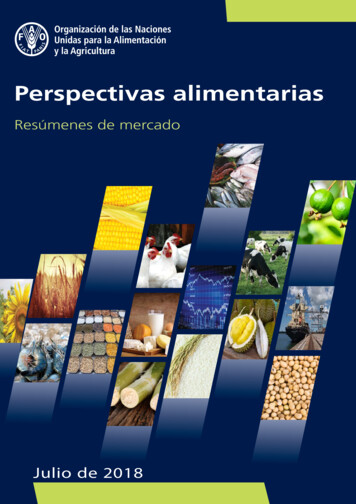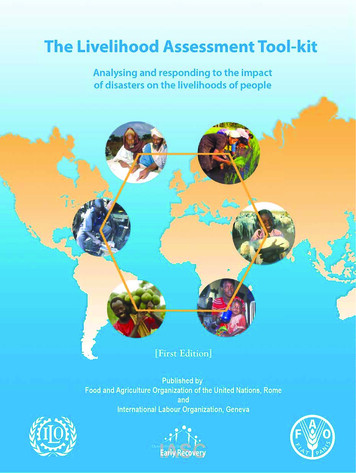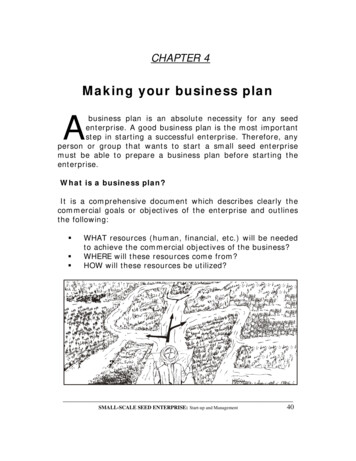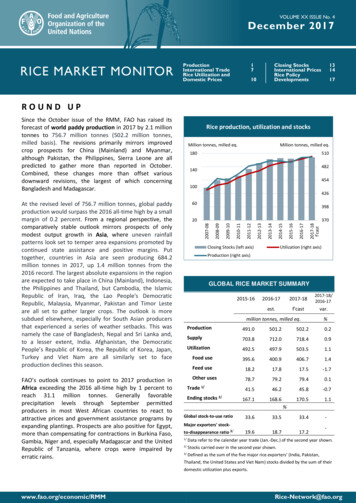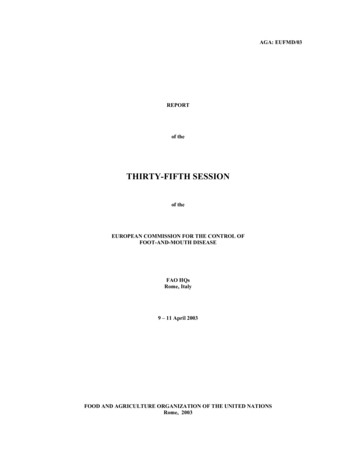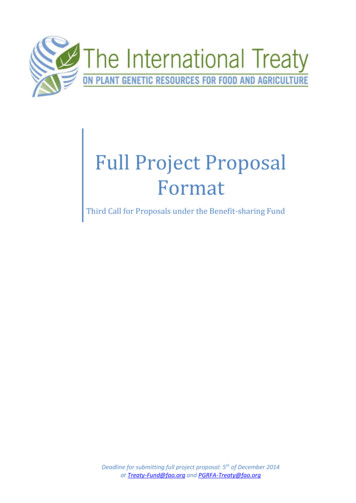
Transcription
Full Project ProposalFormatThird Call for Proposals under the Benefit-sharing FundDeadline for submitting full project proposal: 5th of December 2014at Treaty-Fund@fao.org and PGRFA-Treaty@fao.org
Third Call for Proposals of the Benefit-sharing Fund: Guidelines for the development of full project proposalsTABLE OF CONTENTSProject Proposal cover sheetGeneral requirementsSECTION A: EXECUTIVE SUMMARY1.1.Executive summarySECTION B: PROJECT DESCRIPTION AND CONTENTS2.1. Problem definition2.2. Overall and specific objectives2.3. Targeted outputs, activities and related methodology of implementation2.4. Targeted PGRFA2.5. Direct and indirect beneficiaries2.6. Impact and impact pathways2.6 1. Food security and poverty alleviation2.6.2. Adaptation to climate change and environmental sustainability2.6.3. Scientific impact2.6.4. Capacity development and empowerment2.7. Relevance to national or regional priorities in its plans and programmes for PGRFASECTION C: OPERATIONS3.1. Methodology of project implementation3.2. Partnerships and collaboration arrangements3.3. Project management team3.4. SustainabilitySECTION D: APPENDIXESAppendix:1 Information on the applicantAppendix 2: Logical FrameworkAppendix 3: WorkplanAppendix 4: BudgetAppendix 5: Disbursement informationPage 1
Third Call for Proposals of the Benefit-sharing Fund: Guidelines for the development of full project proposalsPROJECT PROPOSAL COVER SHEETProject No.W2A-PR-200-CubaProject Title:The diversity of forage resources to mitigate the effect of climatechange on livestock systems in Cuba (FITORED)Project duration:24 monthsTarget crops:Andropogon gayanus, Canavalia ensiformis, Trypsacum laxum,Brachiaria spp., Panicum maximum Tithonia diversifolia, Pennisetum purpureum,Leucaena spp., Vigna sp., y Centrosema sp.Targeted developing country/iesCubaOther Contracting Party/ies involvedProject geographic extension (km²) 5 958.19Total requested funding 200 000,00 USDTotal co-funding 2 295 195,50 CUP1 and 200 000,00 USDPlease select the type of project you are applying for:Single-country Immediate Action Project (Window 2)Multi-country Immediate Action Programme (Window 2)Single-country Co-development and Transfer of Technology project (Window 3)Multi-country Co-development and Transfer of Technology project (Window 3)ApplicantName of Organization: Estación Experimental de Pastos y Forrajes “Indio Hatuey”Type of organization Government. Institution for Science, Technology and InnovationProject Contact: (name and position)E-mail address:Telephone:1Official exchange rate 1CUP 1USD.2
Third Call for Proposals of the Benefit-sharing Fund: Guidelines for the development of full project proposalsSECTION A: EXECUTIVE SUMMARY1.Executive summaryThe project aims at minimizing two of the most pressing problems limiting livestockdevelopment in Cuba: the low availability of promise FGR for livestock feed andinadequate access of producers to these resources. To this was plotted as a overallobjective: To contribute to food security, adaptation and mitigation of climate change fromincreasing biodiversity of forage resources in Matanzas and Camagüey covers four specificobjectives: Build a logical framework for participatory dissemination of resources fodderfor local conditions and their conservation; evaluate the effectiveness of the production,preservation and dissemination of forage resources locally, as well as technologies for itsuse; implement a training program that allows to develop skills related to the production,use and conservation of plant genetic resources and, implement an outreach program thatallows the socialization of results and experiences achieved in the project. The mainexpected results relate to the conservation and use of varieties adapted to local conditions,where it is expected that at least 9 varieties will be introduced with a concept of sustainableproduction, based on agro-ecological principles and the characterization of existinggermplasm to the conditions prevailing in local livestock ecosystems; with the transfer andvalidation of technologies for production, conservation and use of seed corresponding tothe different agro-ecosystems of the six municipalities beneficiaries, including the creationof a local system of seed production, seed introduction of new species forage andimplementation of seed production technologies of at least 13 varieties; by implementingmanagement technologies and utilization of herbaceous and tree genetic resources foragricultural production systems, where at least the 5% of the entities and the 70% ofgrazing area will be covered with improved pastures and 100% entities will useagroecological methods of management; by implementating and validating a program tobuild skills in management, utilization and conservation of forage resources to 20 farmsbeneficiaries and by implementating and validating a program for the dissemination ofresults, including the creation an inter-institutional network to access to the information onforage genetic resources, agronomic and livestock management and regionalization ofpasture and forage. The FGR used will be: Andropogon gayanus, Canavalia ensiformis,Tripsacum laxum, M. maximus, Urochloa decumbens, Tithonia diversifolia, Leucaenaleucocephala, Cenchrus purpureum, Vigna unguiculata and Centrosema molle. The 3382direct project beneficiaries are mainly concentrated in two provinces (Matanzas andCamagüey) and six municipalities and are constituted by 2572 farmers in 20 productiveentities, broken down into eight Basic Units of Cooperative Production (UBPCs), 11Cooperative Credit and Services (CCS), an Agricultural Production Cooperative (CPA)and 810 workers from three research centers involved, the Experimental Station ofPastures and Forages "Indio Hatuey", the Institute of Animal Science and the ExperimentalStation of Pastures and Forages Camagüey. The indirect beneficiaries are the 234,095inhabitants of the 6 municipalities with access to the production that is generated by theimplementation of technologies in their territories. The population of Matanzas andCamagüey (1,026,925 inhabitants) provinces will be indirectly affected by the project,which means a geographical extent of involvement of 5 958.19 km2.3
Third Call for Proposals of the Benefit-sharing Fund: Guidelines for the development of full project proposalsSECTION B: PROJECT DESCRIPTION AND CONTENTS2.1. Problem definitionOn a global scale is of particular importance the climate change in the areas dedicated tolivestock (2.2 million hectares), 75% of the soil presents erosion problems and has sincethe last century, drought worsened and the tempeture increased by 0.9ºC. In the last 25years due to economic problems and the damages of climate (droughts, hurricanes, etc.)seed production of pasture and forage in Cuba has been significantly depressed andtherefore the development and introduction to production systems varieties adapted tothese extreme conditions and the reduction of external inputs. This is coupled with poormanagement of livestock grazing areas, which has led to overgrazing and soil erosion,declining fertility, loss of native forests and the decrease of the yield of plants and animals.The lack of integration and management between academia and the productive sector,through the ministries involved, is another aspect that involves the articulation ofagricultural processes and agricultural productivity. The guidelines of economic and socialpolicy of the country indicate accurately the need for a new management model for thesector, encouraging the development of productive forces. In that sense, the guideline 192states: "Continue the development of the livestock vaccination program in activities, swine,poultry and small livestock, enhancing the genetic development of herds and increasedomestic sources of animal feed." The proposed policy for livestock development, theeconomic and financial committee of the National Assembly of Popular Power, approved,among its 13 measures, which states: "Ensuring the cattle feed primarily on pasture,fodder, protein crops and agro-products and the sugar industry . "The action of the projectaims at minimizing two of the most pressing problems limiting livestock development inthe country: the low availability of FGR promising for livestock feed and inadequateaccess of producers to these resources.1. Low availability of promising FGR. There is insufficient access to seed productiontechnology and capacity building for developing these, which affects food security andimport substitution. Seed production of pasture and forage is currently insignificant and donot have a consistent view about the importance of development at the country level. Theimproved pastures have decreased (less than 20%); no grass species are planted, onlyfodder (cane and king-grass); there is little reforestation and significant increase of grazingareas infested by Marabou, an invasive prickly plant, representing more than 30%. Severalscientific institutions have scientific results and related technologies FGR such as:production technologies, processing and storage of seeds, regionalization of herbaceousand tree varieties for different soil and climatic conditions, soil management techniquesand meadows on agro-ecological bases, which may contribute to increased production andimport substitution seed and food, as well as adaptation and mitigation of climate change.However, there is a low utilization and generalization of these results in the productionbase, while there is ignorance by producers of this potential.2. Insufficient access of producers to forage genetic resources. Inadequate integrationbetween the academia and business due to centralized extension system has caused failuresin technology transfer and innovation. With the action of the project is to increasebiodiversity of forage resources, involving the actors in a self-managed and decentralizatedparticipatory plant breeding. This action includes the construction of knowledge producers,enabling increased food production and contribute to adaptation and mitigation of climatechange, from increased soil cover farmers with FGR, which would facilitate the protectionof these by means of biomass in surface and anchoring of this through its root system,mainly in the tree fodder for the large potential in the physical-chemical soil recovery andcapture greenhouse gases.4
Third Call for Proposals of the Benefit-sharing Fund: Guidelines for the development of full project proposals2.2. Project objectives: Overall and specific objectivesOverall objective: To contribute to food security adaptation and mitigation of climatechange from increasing biodiversity of forage resources in Matanzas and Camagüey. Aprocess that demonstrates the impact on food production an increase of the diversity(PGRFA) of species adapted, proper management during periods of food shortage, causedby the severe drought, and the use of correct soil and prairie. Camagüey and Matanzaswere selected because these have a high concentration of people (1,026,925), with highdemands for food and also because the first represents the eastern Cuba, with livestockproduction tradition of milk and meat and, second, to the western region, with strongimpact on livestock production. Empowerment of local producers and actors throughgenerating skills and access to information and knowledge through reflection and actionspaces, and the provision of methodologies and agroecological technologies to accomplishsuch purposes will be preferred. To facilitate the appropriation process mechanisms andexisting institutions to environmental joint municipal level will be activated.Specific objectives: (i) Construct a logical participatory dissemination of fodder resourcesfor local conditions and their conservation scheme. (Ii) evaluate the effectiveness of theproduction, preservation and dissemination of forage resources locally, as well astechnologies for use. iii) Implement a training program that allows to develop skills relatedto production use and conservation of plant genetic resources. (Iiv) Implement an outreachprogram that allows socialization of results and experiences gained in the project. Theproject will work participatory dissemination of forage resources and the implementationand practical demonstration of technologies for seed production level cooperatives andfarms in 6 municipalities and areas of productive, educational performance and servicedelivery. The direct project beneficiaries (farmers and producers of 20 farms selected in the6 municipalities) can increase productivity from the implementation of a set of 13technologies developed in three research centers, the Experimental Station of Pastures andForages Indio Hatuey ( EEPFIH), the Institute of Animal Science (ICA) and theExperimental Station of Pastures and Forages of Camagüey (EEPFC). The added value ofthe action is framed in the fact that it becomes a demonstrative experience that willcatalyze local processes of sustainable agricultural innovation, it will also affect thestrengthening of relations between research and production with a high potential formultiplication and articulation between the scientific and productive sector.2.2. Targeted outputs, activities and related methodology of implementationOutcome 1: Conserved and successfully used varieties adapted to local conditions. Theaction is conceived in two parts 1) the activation of gene banks of the three researchcenters, the integration of these institutions, banks forming seed production in selectedprovinces, to revive the formal flow management on an agroecological basis and 2)Participatory plant breeding involving the artisanal producer and the formal system thatconstitutes an experience that has been developed successfully in Cuba, mainly inagricultural crops. (A.1.1) Development of diagnostic baseline and to identify existingvarieties in production systems and demand flows and relationships of actors in thesystems.
Full Project Proposal Format Third Call for Proposals under the Benefit-sharing Fund Deadline for submitting full project proposal: 5th of December 2014 at Treaty-Fund@fao.org and PGRFA-Treaty@fao.org . Third Call for Proposals of the Benefit-sharing Fund: Guidelines for the development of full project proposals Page 1 TABLE OF CONTENTS Project Proposal cover sheet General
